
ATi All-in-Wonder 9800 Pro
Written by John Yan on 7/28/2003 for
PC
More On:
ATi All-in-Wonder 9800 Pro
You knew ATi, after releasing the Radeon 9800 Pro card, would be thinking about releasing an All-in-Wonder version. As with the All-in-Wonder 9700 Pro being the ultimate video card of it’s time, the All-in-Wonder 9800 Pro seeks to be the ultimate video card currently. If you have the money and you want the best all around card out there, then the All-in-Wonder 9800 Pro is the beast to get.
The packaging is a change from the previous cards. At E3, the ATi representative that I talked to said that retailers wanted smaller boxes so that they can put more products on their shelves. With so many connectors and the remote included with the card, ATi did a remarkable job at reducing the box size.

All the usual suspects included in the previous versions of the card are also included with the All-in-Wonder Radeon 9800 Pro. The remote, of course, comes included for you to control your PC from far away. We’ve done a few reviews here with at Gaming Nexus featuring the remote. Rather than going through it over again you can see Charles Husemann’s review.
The same software bundle as in the last All-in-Wonder card makes its way again to this one. I’d really like to see some different game other than Morrowind bundled in. It’s a nice game and all, but I feel it’s time for something different and perhaps more in the action genre to take advantage of the power of the R350 chipset.
A plethora of connectors comes with the All-in-Wonder Radeon 9800 Pro. If you intend to connect the card to a component TV, ATi has included the connectors necessary for that. ATi has a connector box that attaches to one of the inputs on the card. The box has SVGA inputs, audio inputs, and composite video input. Another multi-connector combo attaches to allow for output of sound and video. There was no way to fit all these connectors on the plate without having to move to a second plate. Even then it still might not be enough room. ATi’s solution of using connector boxes or cables helps keep the card in a one slot solution.

Powering the graphics portion is the R350 chip. Built on the .15 micron process, the R350 clocked at 380MHz. 128MB of DDR memory run at 340MHz. Dual 400MHz DACs and a 165MHz TMDS transmitter allow for multiple monitor support. The chip supports DirectX 9 features and then some. Among the other features are Smoothvision 2.1, Smartshader 2.1, Truform 2.0, Videoshader, and up to 6X full-scene anti-aliasing. Having been out for a little bit now, the Radeon 9800 cards are one of the most powerful 3D accelerators on the market and it powers the latest All-in-Wonder card from ATi. While the regular Radeon 9800 Pro cards have a molex power connectors, the All-in-Wonder 9800 Pro has the old floppy power connector featured in the previous Radeon 9700 Pro cards.

The multimedia portion is, again, powered by the Theater 200 chip. The Theater 200 chip offers video decoding and stereo audio processing. A Philips TV tuner enables TV viewing on your desktop. Up to 125 channels are capable with this tuner. The TV tuner offers a good picture quality with TV and I’ve always been happy with it.
Multimedia Center 8.5 comes with the package and offers some nice new features. The main one I am going to talk about though is Eazylook. Eazylook is a nice display for TVs with large icons and on screen display of information. Working in conjunction with the Remote Wonder, Eazylook makes controlling and viewing TV a lot simpler. For lower resolutions of TVs, Eazylook offers easy to read text and TV settings. One feature I like is the ability to see what’s playing on other channels currently and in the future by using the mouse control pad on the remote. And if you find something you want to record, you can also use the remote to set it up with one touch of the button.



The multimedia center’s Eazylook library now allows you to view a variety of multimedia files on your computer just by using the remote. Files can also be filtered by type. The large letters enable you to easily read the files and select the one you want to view. I really enjoyed the new Eazylook and can’t wait to see more improvements in the software.

To clean up video, Videosoap is employed. You know when you have a weak or dirty cable signal, the video image can be fuzzy or snowy. Various filters are available to help clean up the video and you can use a combination of filters to achieve a good picture. I’ve played around with the feature in previous cards and it certainly can improve picture quality. You’ll have to play around with the settings to produce a picture you prefer but it’s definitely worth using if you can’t get a good picture.
Gemstar Guide+ is the programming guide that gives you show information and times. The program hasn’t changed too much since I first used it with the All-in-Wonder 8500 review but Eazylook takes the information from Guide+ and displays it for you to see on screen when flipping through channels. It offers one touch recording and watching. The program downloads a week’s worth of programming at a time and prompts you to do so when the listings have expired. It still doesn’t allow you to adjust the font size so that it’s easier to read on a TV screen but Eazylook takes care of that now. Still, I hope that new versions of Guide+ allow for some display changes for those that use the card on a TV and doesn’t use want to use Eazylook.
multView is the ability to use a TV Wonder PCI card in conjunction with the All-in-Wonder Radeon 9800 Pro and get picture in picture capabilities or the ability to watch one program while recording another at the same time. You can read about how this is implemented in my TV Wonder Remote Edition review. I tried the card with the All-in-Wonder 9800 Pro and the results were the same.
If you are interested in dual monitor operation, then you’re stuck using a TV as a second monitor. About the only thing missing from this card is that ability, which is available on regular Radeon cards. Dual monitors would be a great addition to this line and I hope ATi decides to include it soon in their future cards somehow.
So let’s get to testing this card on games. My testing setup consisted of:
AMD Barton 2500+
2 - 256 MB PC3200 Crucial ram
ABIT NF7-S
Windows XP Service Pack 1
Maxtor 120 gig 7200 RPM HD
Catalyst 3.5 drivers
Besides running the card through 3D Mark 2001 SE, I decided to run the card through various genres of games. To display a variety of real world games, I used the following products:
Unreal Tournament 2003 - first person shooter
Tom Clancy’s Splinter Cell - third person action game
Comanche 4 - helicopter simulation
All the tests will compare various resolutions with the All-in-Wonder 9700 Pro. On Unreal Tournament 2003 I also compared 4x anti-aliasing and 4x anisotropic filtering with the All-in-Wonder 9700 Pro’s implementation. First up is 3D Mark 2001 SE.
With the controversy surrounding 3D Mark 03, I decided to stick with the older version of the program as the only synthetic benchmark of this review. The tests were conducted through three different resolutions and at default settings.
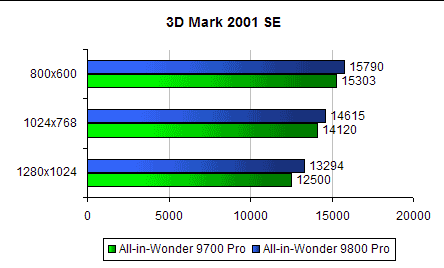
The All-in-Wonder 9800 Pro takes the lead here, as expected, over the All-in-Wonder 9700 Pro. There’s an increase of 500-700 3D marks depending on the resolution over the old card.
Unreal Tournament benchmarks were done using [H]ardOCP’s nice utility. All of the benchmarks were done with flybys at high detail. Here’s the first batch comparing the All-in-Wonder 9700 Pro and the All-in-Wonder 9800 Pro.
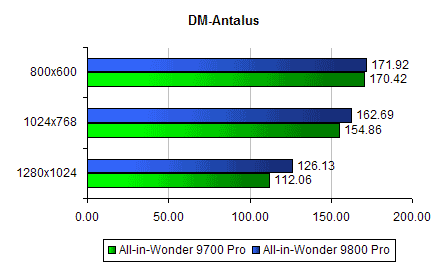
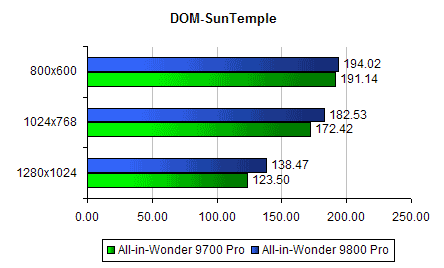
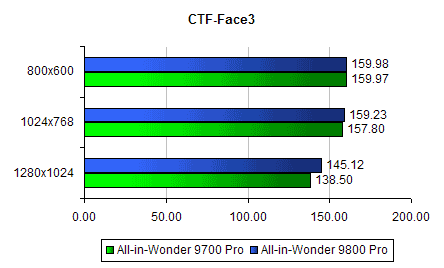
There isn’t much speed difference between the two cards at low resolutions but the All-in-Wonder 9800 Pro starts to pull away as you increase the resolution. Now let’s see how the All-in-Wonder 9800 Pro compares to the All-in-Wonder 9700 Pro when 4x anti-aliasing and 4x anisotropic filtering is turned on.
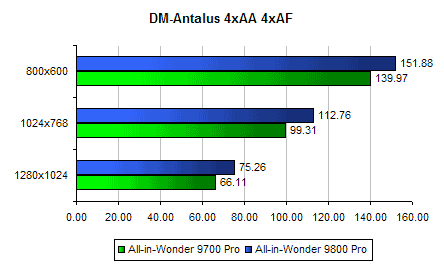
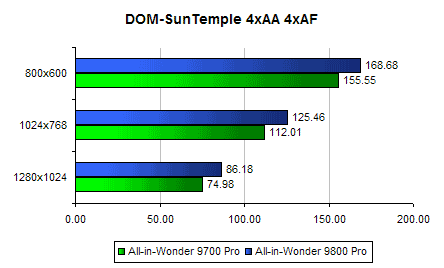
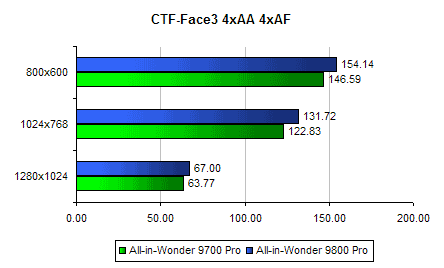
And here is how much speed decrease there is when the features are turned on compared to a normal operation of the All-in-Wonder 9800 Pro.
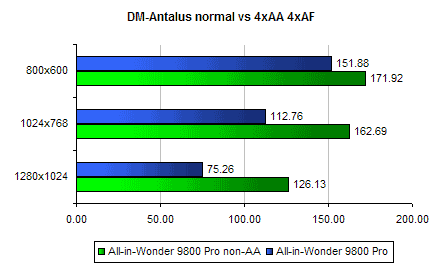
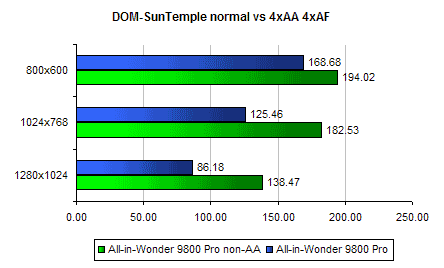
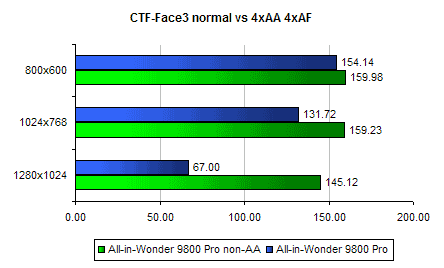
Here’s where the power of the R350 chip shows. As you can see, the R350’s speed differences at the lower levels are more distinct then without anti-aliasing and anisotropic filtering on.
Comanche 4 has a nice demo that we used to benchmark with. The game is more CPU intensive than video intensive, but here are the comparisons between the two. Shaders were enabled for these tests.
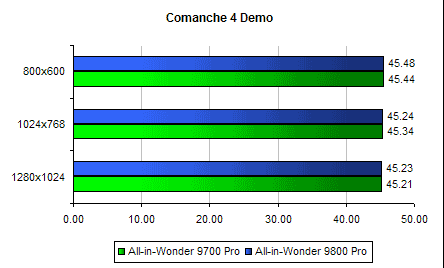
There’s not much difference and just reiterates the fact the game relies on the CPU more so than the video card.
Finally,Tom Clancy’s Splinter Cell, with Beyond3D’s nice little utility, rounds out our benchmarking area. Again, the graph will show how the two cards compare to each other in performance.
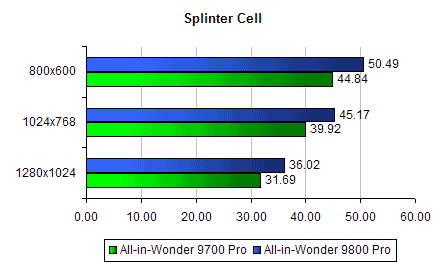
Between the two cards, you’ll benefit if you run the game in higher resolutions on the All-in-Wonder 9800 Pro. Or, if you turn on 4X anti-aliasing and 4X anisotropic filtering, you’ll still be at very acceptable gaming speeds at lower resolutions. Not to say the All-in-Wonder 9700 Pro isn’t capable of great speeds. I’ve turned up all my games to 1280x1024 when using this card now and I found that most of the games run pretty well. They were very playable and suffered very little stuttering in trying to keep up. If you have the power, you might as well use it to the fullest right? The R350 chip delivers great gaming performance at high resolutions giving you a lot of power to play with and more than enough to spare for future games. I’ve really enjoyed the better picture quality and good speeds and found it hard to go back to non-aliased games and lower resolutions.
The power is there to run your games at lightning speeds with many options turned on. Without a doubt, the All-in-Wonder 9800 Pro is the ultimate video card out there now. It lets you play any game at top speeds while offering you a myriad of multimedia functions to boot. It’s a do-it-all card that, while mighty expensive, is the best bang for the buck out there. While you probably don’t want to upgrade if you have the All-in-Wonder 9700 Pro those looking to find the ultimate video card and have the money to spend, look no further. It’s not as big of a jump like from the All-in-Wonder 8500 to the All-in-Wonder 9700 Pro though. But this card does sport one of the fastest 3D chips out there and Multimedia Center 8.5 lets you do a lot for viewing and capturing video.
The packaging is a change from the previous cards. At E3, the ATi representative that I talked to said that retailers wanted smaller boxes so that they can put more products on their shelves. With so many connectors and the remote included with the card, ATi did a remarkable job at reducing the box size.

All the usual suspects included in the previous versions of the card are also included with the All-in-Wonder Radeon 9800 Pro. The remote, of course, comes included for you to control your PC from far away. We’ve done a few reviews here with at Gaming Nexus featuring the remote. Rather than going through it over again you can see Charles Husemann’s review.
The same software bundle as in the last All-in-Wonder card makes its way again to this one. I’d really like to see some different game other than Morrowind bundled in. It’s a nice game and all, but I feel it’s time for something different and perhaps more in the action genre to take advantage of the power of the R350 chipset.
A plethora of connectors comes with the All-in-Wonder Radeon 9800 Pro. If you intend to connect the card to a component TV, ATi has included the connectors necessary for that. ATi has a connector box that attaches to one of the inputs on the card. The box has SVGA inputs, audio inputs, and composite video input. Another multi-connector combo attaches to allow for output of sound and video. There was no way to fit all these connectors on the plate without having to move to a second plate. Even then it still might not be enough room. ATi’s solution of using connector boxes or cables helps keep the card in a one slot solution.

Powering the graphics portion is the R350 chip. Built on the .15 micron process, the R350 clocked at 380MHz. 128MB of DDR memory run at 340MHz. Dual 400MHz DACs and a 165MHz TMDS transmitter allow for multiple monitor support. The chip supports DirectX 9 features and then some. Among the other features are Smoothvision 2.1, Smartshader 2.1, Truform 2.0, Videoshader, and up to 6X full-scene anti-aliasing. Having been out for a little bit now, the Radeon 9800 cards are one of the most powerful 3D accelerators on the market and it powers the latest All-in-Wonder card from ATi. While the regular Radeon 9800 Pro cards have a molex power connectors, the All-in-Wonder 9800 Pro has the old floppy power connector featured in the previous Radeon 9700 Pro cards.

The multimedia portion is, again, powered by the Theater 200 chip. The Theater 200 chip offers video decoding and stereo audio processing. A Philips TV tuner enables TV viewing on your desktop. Up to 125 channels are capable with this tuner. The TV tuner offers a good picture quality with TV and I’ve always been happy with it.
Multimedia Center 8.5 comes with the package and offers some nice new features. The main one I am going to talk about though is Eazylook. Eazylook is a nice display for TVs with large icons and on screen display of information. Working in conjunction with the Remote Wonder, Eazylook makes controlling and viewing TV a lot simpler. For lower resolutions of TVs, Eazylook offers easy to read text and TV settings. One feature I like is the ability to see what’s playing on other channels currently and in the future by using the mouse control pad on the remote. And if you find something you want to record, you can also use the remote to set it up with one touch of the button.



The multimedia center’s Eazylook library now allows you to view a variety of multimedia files on your computer just by using the remote. Files can also be filtered by type. The large letters enable you to easily read the files and select the one you want to view. I really enjoyed the new Eazylook and can’t wait to see more improvements in the software.

To clean up video, Videosoap is employed. You know when you have a weak or dirty cable signal, the video image can be fuzzy or snowy. Various filters are available to help clean up the video and you can use a combination of filters to achieve a good picture. I’ve played around with the feature in previous cards and it certainly can improve picture quality. You’ll have to play around with the settings to produce a picture you prefer but it’s definitely worth using if you can’t get a good picture.
Gemstar Guide+ is the programming guide that gives you show information and times. The program hasn’t changed too much since I first used it with the All-in-Wonder 8500 review but Eazylook takes the information from Guide+ and displays it for you to see on screen when flipping through channels. It offers one touch recording and watching. The program downloads a week’s worth of programming at a time and prompts you to do so when the listings have expired. It still doesn’t allow you to adjust the font size so that it’s easier to read on a TV screen but Eazylook takes care of that now. Still, I hope that new versions of Guide+ allow for some display changes for those that use the card on a TV and doesn’t use want to use Eazylook.
multView is the ability to use a TV Wonder PCI card in conjunction with the All-in-Wonder Radeon 9800 Pro and get picture in picture capabilities or the ability to watch one program while recording another at the same time. You can read about how this is implemented in my TV Wonder Remote Edition review. I tried the card with the All-in-Wonder 9800 Pro and the results were the same.
If you are interested in dual monitor operation, then you’re stuck using a TV as a second monitor. About the only thing missing from this card is that ability, which is available on regular Radeon cards. Dual monitors would be a great addition to this line and I hope ATi decides to include it soon in their future cards somehow.
So let’s get to testing this card on games. My testing setup consisted of:
AMD Barton 2500+
2 - 256 MB PC3200 Crucial ram
ABIT NF7-S
Windows XP Service Pack 1
Maxtor 120 gig 7200 RPM HD
Catalyst 3.5 drivers
Besides running the card through 3D Mark 2001 SE, I decided to run the card through various genres of games. To display a variety of real world games, I used the following products:
Unreal Tournament 2003 - first person shooter
Tom Clancy’s Splinter Cell - third person action game
Comanche 4 - helicopter simulation
All the tests will compare various resolutions with the All-in-Wonder 9700 Pro. On Unreal Tournament 2003 I also compared 4x anti-aliasing and 4x anisotropic filtering with the All-in-Wonder 9700 Pro’s implementation. First up is 3D Mark 2001 SE.
With the controversy surrounding 3D Mark 03, I decided to stick with the older version of the program as the only synthetic benchmark of this review. The tests were conducted through three different resolutions and at default settings.

The All-in-Wonder 9800 Pro takes the lead here, as expected, over the All-in-Wonder 9700 Pro. There’s an increase of 500-700 3D marks depending on the resolution over the old card.
Unreal Tournament benchmarks were done using [H]ardOCP’s nice utility. All of the benchmarks were done with flybys at high detail. Here’s the first batch comparing the All-in-Wonder 9700 Pro and the All-in-Wonder 9800 Pro.



There isn’t much speed difference between the two cards at low resolutions but the All-in-Wonder 9800 Pro starts to pull away as you increase the resolution. Now let’s see how the All-in-Wonder 9800 Pro compares to the All-in-Wonder 9700 Pro when 4x anti-aliasing and 4x anisotropic filtering is turned on.



And here is how much speed decrease there is when the features are turned on compared to a normal operation of the All-in-Wonder 9800 Pro.



Here’s where the power of the R350 chip shows. As you can see, the R350’s speed differences at the lower levels are more distinct then without anti-aliasing and anisotropic filtering on.
Comanche 4 has a nice demo that we used to benchmark with. The game is more CPU intensive than video intensive, but here are the comparisons between the two. Shaders were enabled for these tests.

There’s not much difference and just reiterates the fact the game relies on the CPU more so than the video card.
Finally,Tom Clancy’s Splinter Cell, with Beyond3D’s nice little utility, rounds out our benchmarking area. Again, the graph will show how the two cards compare to each other in performance.

Between the two cards, you’ll benefit if you run the game in higher resolutions on the All-in-Wonder 9800 Pro. Or, if you turn on 4X anti-aliasing and 4X anisotropic filtering, you’ll still be at very acceptable gaming speeds at lower resolutions. Not to say the All-in-Wonder 9700 Pro isn’t capable of great speeds. I’ve turned up all my games to 1280x1024 when using this card now and I found that most of the games run pretty well. They were very playable and suffered very little stuttering in trying to keep up. If you have the power, you might as well use it to the fullest right? The R350 chip delivers great gaming performance at high resolutions giving you a lot of power to play with and more than enough to spare for future games. I’ve really enjoyed the better picture quality and good speeds and found it hard to go back to non-aliased games and lower resolutions.
The power is there to run your games at lightning speeds with many options turned on. Without a doubt, the All-in-Wonder 9800 Pro is the ultimate video card out there now. It lets you play any game at top speeds while offering you a myriad of multimedia functions to boot. It’s a do-it-all card that, while mighty expensive, is the best bang for the buck out there. While you probably don’t want to upgrade if you have the All-in-Wonder 9700 Pro those looking to find the ultimate video card and have the money to spend, look no further. It’s not as big of a jump like from the All-in-Wonder 8500 to the All-in-Wonder 9700 Pro though. But this card does sport one of the fastest 3D chips out there and Multimedia Center 8.5 lets you do a lot for viewing and capturing video.
While it's certainly one of the most expensive video cards out there, it's also one of the best. Watch TV, videos, DVDs, and play games at high speeds. The All-in-Wonder 9800 Pro does it all and does it well.
Rating: 9.1 Class Leading
* The product in this article was sent to us by the developer/company.

About Author
I've been reviewing products since 1997 and started out at Gaming Nexus. As one of the original writers, I was tapped to do action games and hardware. Nowadays, I work with a great group of folks on here to bring to you news and reviews on all things PC and consoles.
As for what I enjoy, I love action and survival games. I'm more of a PC gamer now than I used to be, but still enjoy the occasional console fair. Lately, I've been really playing a ton of retro games after building an arcade cabinet for myself and the kids. There's some old games I love to revisit and the cabinet really does a great job at bringing back that nostalgic feeling of going to the arcade.
View Profile